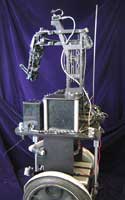Accoding to a news report the Universal Design Company (UniCo) is proposing to refit the disused Mitsubishi's Tonsley Park car plant in Adelaide to assemble alternative fuel "green" vehicles. The cars would initially have V6 engines capable of running on biofuel and LPG, with hybrid electric engines later.
The plan envisages the first cars made by 2009, so presumably these will be assembled from imported components, using an existing design. It take several years to design a car and more to make the parts.
The plan is said to be support ed by the Australian Manufacturing Workers Union. But it is difficult to see how a plant making a small number of cars (30,000 per year) could be cost effectively assembled in Australia, unless some radical new technology is used. Dual fuel LPG/biofuel engines do not appear breakthrough technology.
... Under the plan, car parts and "trans-hybrid" engines would be shipped to Adelaide and assembled at Tonsley Park to produce specialised people movers and easy-access vehicles seating up to seven people. The V6 engines would initially be dual-fuelled, running on biofuel and LPG, with plans to introduce electric hybrid engines in the future. ...Southern Suburbs Minister John Hill, who is in charge of redeveloping the site, said there was a high level of interest and "lots of exciting propositions".
"I would welcome the interest from this company," he said.
Expressions of interest for the site, being collected by Mitsubishi, close today. ...
From: Secret bid to build 'green' cars at Mitsubishi plant, LAUREN NOVAK, The Advertiser, Adelaide, March 21, 2008 12:10am
According to the news report, Universal Design Company (UniCo), was formed by Chris Burrell, who previously started UniCab Australia. An ASIC search shows that "UNIVERSAL DESIGN CO. (UNICO)" is a business name registered with the Office of Fair Trading, New South Wales (no:
NSW BN98311428). There does not appear to be a web site for UniCo. The web site for UniCab <
http://www.unicab.com.au/> is now "parked" by Primus Telecommunications PTY LTD.
Premier of South Australia is in India, discussing business opportunities. These mostly seem to be about mines and some about defence industry. These seem more likely ways to redeploy the workforce from the closing Mitsubishi car plant.
INDIAN INDUSTRIES searching for new avenues in mining and exploration can now look forward to setting base in South Australia. The South Australian premier, Mike Rann has asked Indian businessmen to enter into joint ventures and partnerships with companies in his province in mining and exploration. He said that huge opportunities existed for mining copper, uranium, gold, zinc and zircon in South Australia. He was speaking at an interactive meeting organised by the Federation of Indian Chamber of Commerce and Industries (FICCI) in New Delhi.
Speaking at the meeting, Rann also invited the Indian entrepreneurs to have tie-ups in the defence sector, which includes shipbuilding, submarine support, systems integration, electronic warfare, surveillance, research and development. ...
From:
South Australia invites India for mining, defence ties, Mineguruji, MeriNews, 14 March 2008
Also a
consortium of Indian universities is to establish a campus in Adelaide. It is unlikely that many ex-car plant workers will be employed there, but this might be a better prospect for the South Australian economy, than a car plant:
The Icfai University has entered a memorandum of understanding (MoU) with the state of South Australia to set up its campus at Adelaide.
Initially, the university is planning to launch postgraduate management programmes in a leased space in Adelaide this year before setting up a full-fledged campus with other courses over a period.
The MoU was signed by the visiting South Australia premier Mike Rann and Icfai University chairman Subhash Sarnikar here on Saturday. ...
.... The students would spend a year in the Icfai campus in Adelaide and the second year at an existing university.
In the process, they get degrees or diplomas from both the universities ...
From: Icfai to set up campus in South Australia, BS Reporter, Business Standard Ltd, Hyderabad, March 17, 2008
Labels: Cars, Creative Industries, Electric Vehicle













